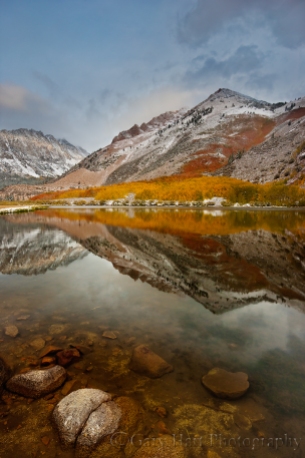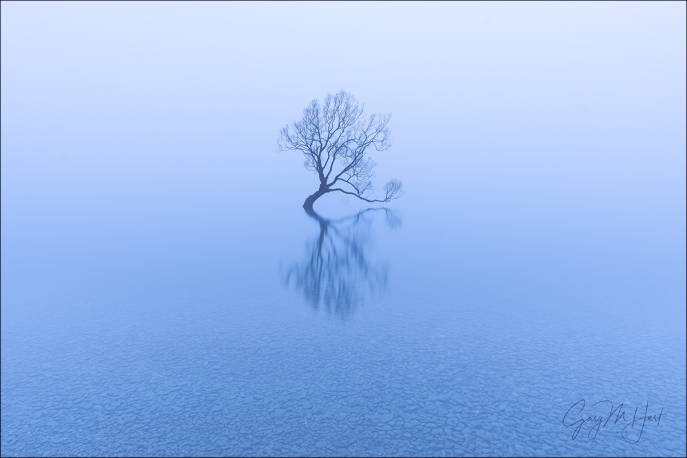Eloquent Images by Gary Hart
Insight, information, and inspiration for the inquisitive nature photographer
Reflections
Reflection
Dictionary.com: The return of light, heat, sound, etc., after striking a surface.
Okay, so that’s pretty basic. How about this one?
Wikipedia: The change in direction of a wavefront at an interface between two different media so that the wavefront returns into the medium from which it originated
Whoa—I hope that’s not on the test.
Who doesn’t love the soothing tranquility of a crisp reflection? And like a metaphor in writing, a reflection is an indirect representation that can be more powerful than its literal double thanks to its ability to engage the brain in different ways than we’re accustomed. Rather than processing the scene directly, our brains reassemble the reflection’s reverse world, and in the process perhaps see the scene a little differently.
Reflections are a powerful photographic tool as well. Water’s universal familiarity makes it an ideal subject for photographers frustrated by their camera’s static representation of our dynamic world. Just as we freeze or blur a waterfall to express turbulent motion, we can include a reflection to convey serenity.
Water reflections come in many forms, from a mirror-sharp inverted mountain peak shimmering in a still pool, to an abstract shuffle of color and texture on a gently undulating lake. Without getting too far into the physics of light, it’s important to understand that every object we see and photograph that doesn’t generate its own light comes to us courtesy of reflected light. For example, when sunlight strikes Half Dome in Yosemite, some of the sun’s photons bounce straight back into our eyes, and there it is.
But other photons head off at different angles—some to be captured by other sets of eyes, while others land on the surface of the Merced River far below. A few of these photons penetrate the water to illuminate detail in the submerged riverbed, while others, like a billiard ball ricocheting of the table’s cushion, carom off in the other direction but at the same angle at which they struck the water. When these photons reach our eyes, we see a reflection. In other words, what we know as a reflection is in fact re-reflected light (reflected first from Half Dome, then by the river).
The recipe for a mirror reflection

Autumn Reflection, El Capitan and Three Brothers, Yosemite
The ingredients for a crisp, mirror reflection is pretty simple: still water, a sunlit subject that’s much brighter than the water’s surface (the greater the contrast the better), and a view angle that matches the angle from the water’s surface to the reflection subject. (The best reflections are usually found on shaded water because there are fewer photons competing with the reflection’s photons.)
In the image on the left, with El Capitan in direct sunlight but the slow moving Merced River still shaded, my biggest challenge was finding floating fall leaves to include with my reflection. Once I found this spot, I used my Sony 12-24 f/2.8 GM lens (on my Sony a7RIV body) for a field of view just wide enough to fit El Capitan, Three Brothers, the reflection, and the floating leaves.

Sunset Palette, Half Dome from Sentinel Dome, Yosemite
Playing the angles
Understanding that reflected photons leave the water’s surface at the same angle at which they arrive—imagine the way a tennis player anticipates the ball’s bounce to get in position—allows us to position ourselves to get the reflection we want. And standing as close to the water as possible (I actually try to get my tripod into the water whenever possible) is the best way to get the most reflection, eliminate distracting shoreline, and avoid including other photographers in your frame.
One summer evening I found myself atop Sentinel Dome shortly after runoff from an intense rain shower had turned indentations in the granite into small, still pools. I could see that the ingredients for a sunset would soon align, but rather than simply settle for vivid color above Half Dome, I wanted to include the sunset reflected in the pools as well. At eye-level the pools reflected nothing but blue sky, so I dropped my tripod almost to granite level, until my lens was at the angle to catch the red light leaving the clouds bouncing off the water.
When the water’s in motion

Red Sunset, Lake Wanaka, New Zealand
As spectacular as a crisp, mirror reflection in still water is, it’s easy to overlook the visual potential of a reflection that’s not crisp, or to forget your camera’s ability to render a soft or abstract reflection much better than your eyes view it. While a crisp reflection can dominate the primary subject in an image, a splash of reflected color or shape can beautifully accent a striking primary subject. And a reflection that’s lost to the continuously varying angles of rippled or choppy water (the light still reflects, but the angle changes with the moving water), magically appears as soft outline when a long exposure smoothes the water’s surface.
In this image from Lake Wanaka on the South Island of New Zealand, all the ingredients were in place for a special sunset reflection until a light breeze stirred the lake’s surface with gentle undulations. By attaching a Breakthrough 6-stop neutral density filter to my Sony 24-105 f/4 G lens (Sony a7RIII camera), I was able to achieve a 30-second exposure that complete smoothed the lake’s surface. While not a perfect mirror, the resulting reflection has a very pleasing soft, gauzy look. The long exposure smoothed the distant clouds as well.
Where to focus

Autumn Reflection, El Capitan, Yosemite
An often misunderstood factor when photographing reflections is where to focus. Though counterintuitive to some, the focus point of a reflection is the reflection’s subject, not its reflecting surface. This isn’t such a big deal when the focus point of everything in the frame is infinity, but it’s a very big deal when you want both your reflection and nearby rocks or leaves (on or in the nearby water’s surface) sharp.
The El Capitan reflection and autumn leaves on the right required impossible depth of field to capture sharpness throughout. Even though the leaves floated atop the El Capitan reflection, focusing on El Capitan’s reflection would have softened the the leaves. To increase my depth of field, I stopped down to f/18 and focused toward the back of the foreground leaves, then magnified the image on my LCD to verify that all of the leaves were sharp. Though El Capitan is slightly soft, a soft reflection is almost always more forgivable than a soft foreground.
Think ahead
It seems that reflections often feel like a fortuitous gift that we just stumbled upon. But given that reflections are entirely beholden to the laws of physics, they’re far more predictable than many of the natural elements we photograph. Taking a little time to understand the nature of reflections and how they’re revealed by a camera enables photographers to anticipate their appearance and craft striking images.
Workshop Schedule || Purchase Prints || Instagram
Reflections Around the World
Click an image for a closer look, and to view a slide show.


























































